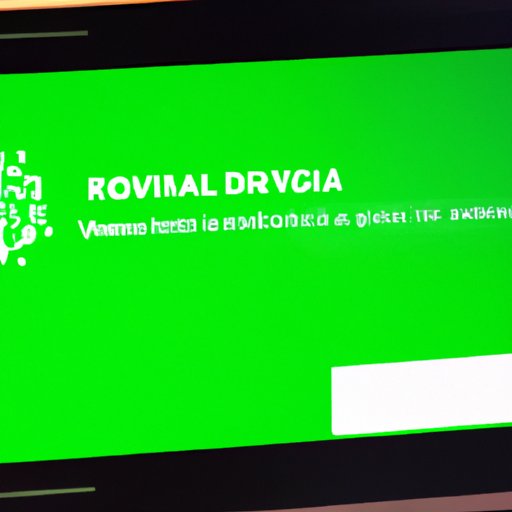Introduction
If you’re having trouble with your Nvidia graphics card, it may be time to rollback the driver. Rolling back the driver means uninstalling the current version and replacing it with an older one. This process can help resolve any issues you may have encountered after a driver update, as well as decrease any bugs or instability in the system.
In this article, we will discuss how to rollback Nvidia drivers and provide step-by-step instructions on how to use Device Manager, Windows System Restore, downloading and installing an older version of the driver, using a display driver uninstaller, manually deleting all Nvidia files from your system, and using a driver update tool.
Use Device Manager to Uninstall or Rollback the Nvidia Driver
The first method for rolling back your Nvidia driver is to use Device Manager. To do this, follow these steps:
1. Press the Windows key + R to open the Run window. Type “devmgmt.msc” and press Enter to open the Device Manager.
2. Expand the Display Adapters section and right-click on your Nvidia graphics card. Select “Uninstall device” from the menu.
3. When prompted, check the box next to “Delete the driver software for this device” and click OK.
4. Restart your computer and wait for Windows to automatically install the default driver for your graphics card.

Use Windows System Restore to Rollback the Nvidia Driver
Another way to rollback your Nvidia driver is to use Windows System Restore. This method allows you to restore your system to a previous point in time before you installed the driver update. To do this, follow these steps:
1. Press the Windows key + R to open the Run window. Type “sysrestore” and press Enter to open the System Restore window.
2. Click “Next” to start the restore process.
3. Select the date and time before you installed the driver update and click “Next”.
4. Review the summary of the restore process and click “Finish” to begin the restoration.
5. Once the restoration is complete, restart your computer.

Download and Install an Older Version of the Nvidia Driver
Another option for rolling back your Nvidia driver is to download and install an older version of the driver. To do this, follow these steps:
1. Visit the official Nvidia website and download the version of the driver you want to install. Make sure to choose the correct version for your operating system.
2. Once the download is complete, double-click the file to begin the installation process.
3. Follow the on-screen instructions to complete the installation.
4. Once the installation is complete, restart your computer.
Use Display Driver Uninstaller to Rollback the Nvidia Driver
Display Driver Uninstaller (DDU) is a third-party tool that can be used to completely remove your Nvidia driver and its associated files. To do this, follow these steps:
1. Download the latest version of DDU from the official website.
2. Double-click the file to begin the installation process.
3. Select “Clean and restart” when prompted, then follow the on-screen instructions to complete the installation.
4. Once the installation is complete, restart your computer.
Manually Delete All Nvidia Files from Your System
If you want to completely remove all Nvidia files from your system, you can do so by manually deleting them. To do this, follow these steps:
1. Press the Windows key + R to open the Run window. Type “%programfiles%\NVIDIA Corporation” and press Enter to open the Nvidia folder.
2. Right-click the “Display.Driver” folder and select “Delete” from the menu.
3. Repeat this process for any other Nvidia folders you find in the Program Files folder.
4. Now press the Windows key + R again to open the Run window. Type “%appdata%\NVIDIA Corporation” and press Enter to open the Nvidia folder.
5. Right-click the “Display.Driver” folder and select “Delete” from the menu.
6. Repeat this process for any other Nvidia folders you find in the AppData folder.

Use a Driver Update Tool to Rollback the Nvidia Driver
Finally, you can use a driver update tool to rollback your Nvidia driver. This method allows you to quickly and easily uninstall the current version of the driver and replace it with an older one. To do this, follow these steps:
1. Download and install a driver update tool such as Driver Booster or Driver Talent.
2. Open the driver update tool and click “Scan” to search for outdated drivers.
3. Once the scan is complete, locate your Nvidia graphics card in the list of results and click “Roll Back”.
4. Follow the on-screen instructions to complete the rollback process.
Conclusion
Rolling back your Nvidia driver can help resolve any issues you may have encountered after a driver update, as well as decrease any bugs or instability in the system. In this article, we discussed how to rollback Nvidia drivers and provided step-by-step instructions on how to use Device Manager, Windows System Restore, downloading and installing an older version of the driver, using a display driver uninstaller, manually deleting all Nvidia files from your system, and using a driver update tool.
To avoid driver issues in the future, be sure to keep your drivers up to date by regularly checking the manufacturer’s website for updates. You should also use a driver update tool to ensure that your drivers are always up to date.


